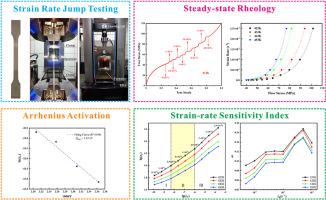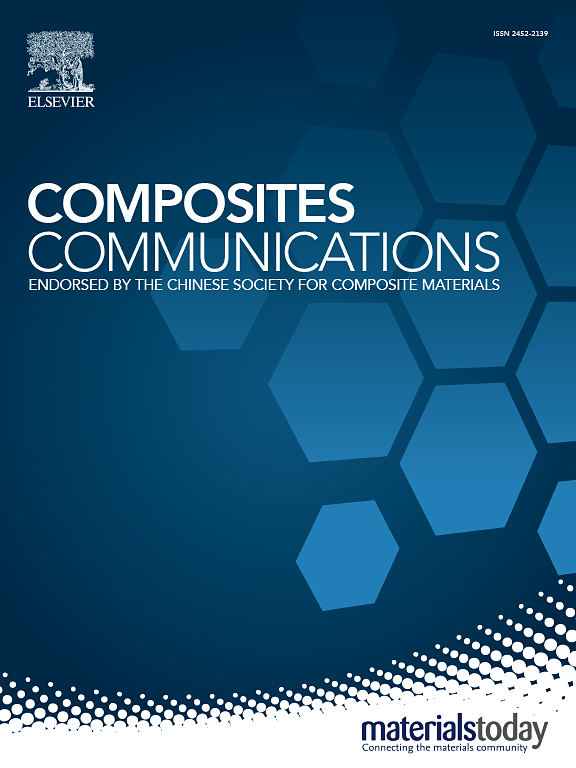通过应变速率跃迁拉伸试验确定 PEEK 的高温稳态流变行为和阿伦尼乌斯活化特性
IF 6.5
2区 材料科学
Q1 MATERIALS SCIENCE, COMPOSITES
引用次数: 0
摘要
聚醚醚酮(PEEK)是一种高性能热塑性聚合物,在航空航天、汽车、电子和医疗设备等领域有着广泛的工业应用。然而,对其高温流变特性的系统研究还很不够。本研究采用应变速率跃迁拉伸试验来研究 PEEK 在四种不同温度和九种不同应变速率下的稳态流变现象和应变速率敏感性。此外,还根据自由体积理论和阿伦尼乌斯定律进行了理论分析,进一步分析了 PEEK 从牛顿流体到非牛顿流体的转变过程。结果表明,PEEK 材料在高温条件下表现出与金属材料类似的从牛顿流体向非牛顿流体的转变。从牛顿流体到非牛顿流体的过渡点以稳态流变及其特征应力的出现为标志。理论分析表明,PEEK 的转变符合阿伦尼乌斯低值。此外,它的表观活化能(1.42 eV)明显低于金属材料的表观活化能(5.28 eV),这表明它的能障较低,更容易发生转变。应变速率敏感性指数与温度升高呈负相关,尤其是在较低的速率下。这项研究加深了人们对 PEEK 高温流变特性的了解,有助于高性能热塑性材料的开发和应用。本文章由计算机程序翻译,如有差异,请以英文原文为准。

Characterize the high-temperature steady-state rheological behavior and Arrhenius activation of PEEK via strain rate jump tensile tests
Polyetheretherketone (PEEK) is a high-performance thermoplastic polymer with diverse industrial applications, such as aerospace, automotive, electronics, and medical devices. However, systematic research on its high-temperature rheological characteristics is inadequate. In this study, strain rate jump tensile tests were introduced to examine the steady-state rheology phenomena and strain rate sensitivity of PEEK at four different temperatures and nine different strain rates. Theoretical analysis based on the free volume theory and the Arrhenius law was also carried out to further analyze the transition of PEEK from Newtonian flow to non-Newtonian flow. Results indicate that PEEK materials exhibit a transition from Newtonian flow to non-Newtonian flow similar to metal materials at high temperatures. The transition point from Newtonian flow to non-Newtonian flow is marked by the emergence of steady-state rheology and its characteristic stress. Theoretical analysis demonstrates that the transition of PEEK is in accordance with the Arrhenius low. Moreover, its apparent activation energy (1.42 eV) is significantly lower than that of metal materials (5.28 eV), indicating a lower energy barrier and an easier transition. The strain rate sensitivity index correlates negatively with rising temperatures, especially at lower rates. This study enhances understanding of PEEK's rheological characteristics at high temperatures, aiding the development and application of high-performance thermoplastic materials.
求助全文
通过发布文献求助,成功后即可免费获取论文全文。
去求助
来源期刊

Composites Communications
Materials Science-Ceramics and Composites
CiteScore
12.10
自引率
10.00%
发文量
340
审稿时长
36 days
期刊介绍:
Composites Communications (Compos. Commun.) is a peer-reviewed journal publishing short communications and letters on the latest advances in composites science and technology. With a rapid review and publication process, its goal is to disseminate new knowledge promptly within the composites community. The journal welcomes manuscripts presenting creative concepts and new findings in design, state-of-the-art approaches in processing, synthesis, characterization, and mechanics modeling. In addition to traditional fiber-/particulate-reinforced engineering composites, it encourages submissions on composites with exceptional physical, mechanical, and fracture properties, as well as those with unique functions and significant application potential. This includes biomimetic and bio-inspired composites for biomedical applications, functional nano-composites for thermal management and energy applications, and composites designed for extreme service environments.
 求助内容:
求助内容: 应助结果提醒方式:
应助结果提醒方式:


